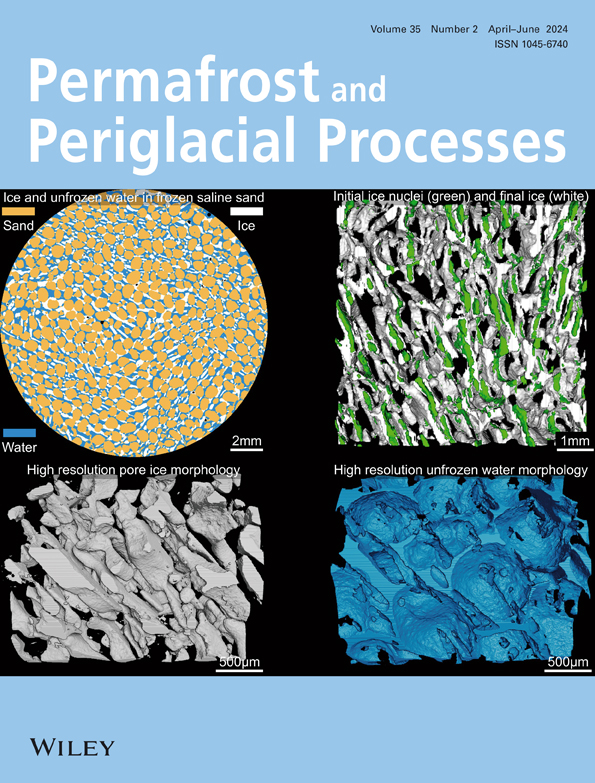Disparate permafrost terrain changes after a large flood observed from space
IF 3.3
3区 地球科学
Q2 GEOGRAPHY, PHYSICAL
引用次数: 0
Abstract
Abstract The 2015 spring flood of the Sagavanirktok River inundated large swaths of tundra as well as infrastructure near Prudhoe Bay, Alaska. Its lasting impact on permafrost, vegetation, and hydrology is unknown but compels attention in light of changing Arctic flood regimes. We combined InSAR and optical satellite observations to quantify subdecadal permafrost terrain changes and identify their controls. While the flood locally induced quasi‐instantaneous ice‐wedge melt, much larger areas were characterized by subtle, spatially variable post‐flood changes. Surface deformation from 2015 to 2019 estimated from ALOS‐2 and Sentinel‐1 InSAR varied substantially within and across terrain units, with greater subsidence on average in flooded locations. Subsidence exceeding 5 cm was locally observed in inundated ice‐rich units and also in inactive floodplains. Overall, subsidence increased with deposit age and thus ground ice content, but many flooded ice‐rich units remained stable, indicating variable drivers of deformation. On average, subsiding ice‐rich locations showed increases in observed greenness and wetness. Conversely, many ice‐poor floodplains greened without deforming. Ice wedge degradation in flooded locations with elevated subsidence was mostly of limited intensity, and the observed subsidence largely stopped within 2 years. Based on remote sensing and limited field observations, we propose that the disparate subdecadal changes were influenced by spatially variable drivers (e.g., sediment deposition, organic layer), controls (ground ice and its degree of protection), and feedback processes. Remote sensing helps quantify the heterogeneous interactions between permafrost, vegetation, and hydrology across permafrost‐affected fluvial landscapes. Interdisciplinary monitoring is needed to improve predictions of landscape dynamics and to constrain sediment, nutrient, and carbon budgets.从太空观测到的大洪水后,不同的永久冻土地形发生了变化
2015年,Sagavanirktok河的春季洪水淹没了阿拉斯加普拉德霍湾附近的大片苔原和基础设施。它对永久冻土、植被和水文的持久影响尚不清楚,但鉴于北极洪水状况的变化,它引起了人们的注意。我们结合InSAR和光学卫星观测,量化了年代际冻土的地形变化,并确定了其控制因素。虽然洪水局部诱发了准瞬时冰楔融化,但更大的区域在洪水后发生了微妙的空间变化。从ALOS‐2和Sentinel‐1 InSAR估计的2015年至2019年的地表变形在地形单元内部和不同地形单元之间变化很大,在被淹没的地区平均沉降更大。在被淹没的富冰单元和不活跃的洪泛区,局部观测到下沉超过5厘米。总体而言,沉降随着沉积年龄和地面冰含量的增加而增加,但许多被淹没的富冰单元保持稳定,表明变形的驱动因素是可变的。平均而言,下沉的富冰地区显示出观测到的绿色和湿度的增加。相反,许多缺乏冰的洪泛平原在没有变形的情况下变绿了。沉降升高的淹没区冰楔退化强度有限,沉降在2年内基本停止。基于遥感和有限的野外观测,我们提出不同的年代际变化受到空间变量驱动因素(如沉积物沉积、有机层)、控制因素(地面冰及其保护程度)和反馈过程的影响。遥感有助于量化冻土、植被和水文在受冻土影响的河流景观之间的非均匀相互作用。需要跨学科的监测来改善对景观动态的预测,并限制沉积物、养分和碳预算。
本文章由计算机程序翻译,如有差异,请以英文原文为准。
求助全文
约1分钟内获得全文
求助全文
来源期刊
CiteScore
9.70
自引率
8.00%
发文量
43
审稿时长
>12 weeks
期刊介绍:
Permafrost and Periglacial Processes is an international journal dedicated to the rapid publication of scientific and technical papers concerned with earth surface cryogenic processes, landforms and sediments present in a variety of (Sub) Arctic, Antarctic and High Mountain environments. It provides an efficient vehicle of communication amongst those with an interest in the cold, non-glacial geosciences. The focus is on (1) original research based on geomorphological, hydrological, sedimentological, geotechnical and engineering aspects of these areas and (2) original research carried out upon relict features where the objective has been to reconstruct the nature of the processes and/or palaeoenvironments which gave rise to these features, as opposed to purely stratigraphical considerations. The journal also publishes short communications, reviews, discussions and book reviews. The high scientific standard, interdisciplinary character and worldwide representation of PPP are maintained by regional editorial support and a rigorous refereeing system.

 求助内容:
求助内容: 应助结果提醒方式:
应助结果提醒方式:


